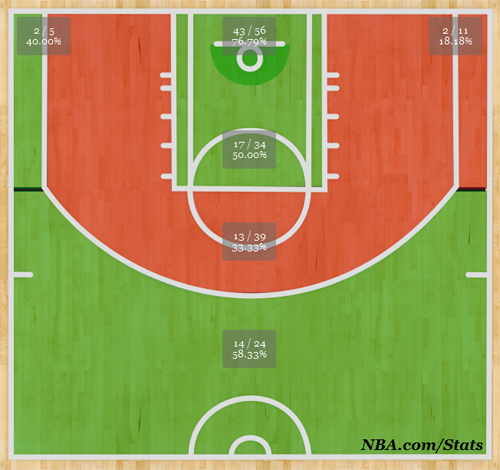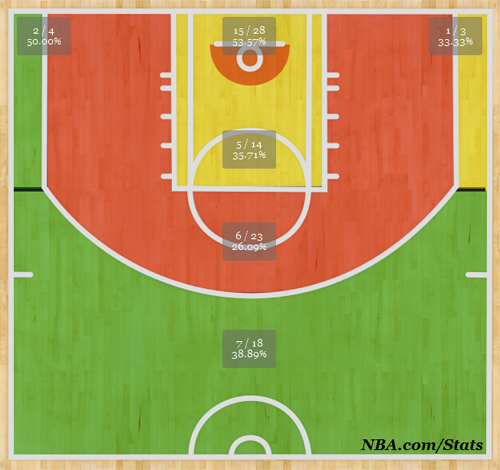How Serge Ibaka Led the Thunder Resurrgence in Game 3 of the Western Conference Finals

Over the last 10 days, the Oklahoma City Thunder have gone from looking like legitimate title contenders against the Clippers, to hopelessly lost and all but counted out in Games 1 and 2 against the Spurs, to potentially revitalized and back in this thing after Game 3.
Thus, it would seem, is the Serge Ibaka effect.
The above timeline of events took place over a period of roughly 10 days in which Ibaka went down with a pretty serious calf injury, was subsequently ruled out for the remainder of the postseason before Game 1 of the Western Conference Finals, then somehow came back and played close to 30 effective and series-altering minutes in Game 3.
He posted an impressive line of 15 points on 6 of 7 shooting, 7 rebounds, 4 blocked shots (with several more altered), and 1 steal in his return. He didn’t waste any time getting going either, as he put up 8 of his 15 points in the first quarter (4 of 4 from the floor) to go with 3 rebounds and 2 blocks.
Other than the occasional signs of fatigue and the on-again-off-again limp that one would expect from someone who had suffered a Grade 2 calf strain 10 days prior, the man looked great. One could even argue that he was perhaps the best player on the floor in the Thunder’s impressive 106-97 bounce-back win.
As we discussed last week, Ibaka’s impact on the Thunder on both ends of the floor is hard to replace. They certainly tried by attempting to plug circle-shaped Nick Collison and Steven Adams pegs into the square-shaped hole left by Ibaka, but nothing really caught on or had the desired effect.
They got everything they would want from Ibaka upon his return to the court, however. And the proof of his impact, as they say, is in the statistical pudding.
Paint Protection
In Games 1 and 2, the Spurs shot 43 for 56 (76.8%) in the restricted area and 60 of 90 (66.7%) overall in the paint. As you see below, the painted area was glowing green for the Spurs (which represents the fact that they shot above league average in both the restricted and non-restricted areas) over the first two games of the series.

Game 3 was a totally different story. With Ibaka looming large, the Spurs only shot 15 of 28 (53.6%) in the restricted area and 20 of 42 (47.6%) in the paint overall. The green faded to league-average levels in the non-restricted area (represented below in yellow) and below league average in the restricted space (represented in red).

Just looking at those two shot charts together, it’s no trouble to see that the paint was much better protected in Game 3 than it was in the first two games of the series. Ibaka faced 13 shots at the rim himself in the third game, according to SportVU’s player tracking data, and the Spurs were only able to convert on 6 of them (46.2%). That’s a far cry from the 76.8% they were able to shoot around the rim in Games 1 and 2. After scoring an average of 60 points in the paint per game over their first two wins, the Spurs only managed 40 in their Game 3 loss.
The Ibaka Effect
For a more acute example of the Ibaka effect, just take a look at Tony Parker's accuracy in the paint between the San Antonio wins and losses. In the Spurs' Game 1 and 2 victories, Parker was a big deciding factor, averaging 18.0 points per game and shooting 13 of 17 in the paint (76.4%). In Game 3? He scored only 9 points in total and shot 3 of 9 in the paint (33.3%).
Parker's primary defender Russell Westbrook obviously gets some of the credit here, but that dip in effectiveness when in the paint is the effect that Ibaka has on opposing players. His looming presence keeps percentages down, even on the shots he doesn't block. The Thunder having Ibaka back in this series could be enough to neutralize the threat of Parker's drives, which have been a big part of his team's success this postseason (he leads all postseason performers with 11.9 drives per game and connects on 50.5% of his attempts).
Overall Contributions
Overall, the Spurs shot only 39.6% from the field in Game 3, compared to a combined 53.8% over Games 1 and 2. The extra big body for the Thunder also translated into extra rebounding chances as well, as the Thunder went from being out-rebounded by the Spurs 93-75 over Games 1 and 2 to doing the out-rebounding with a decisive 52-36 edge in Game 3.
It wasn’t just on the defensive end that Ibaka flourished either. When he was on the court, his mid-range game helped spread the floor for the Thunder quite a bit. The resulting 125.7 offensive rating (points per 100 possessions) that the Thunder had when Serge was in the game was quite staggering compared to the 85.8 that they had when he was on the bench.
The New Starting Five
The re-insertion of Ibaka into the starting lineup was a big part of the turnaround in Game 3, but the Thunder’s often maligned Coach Scott Brooks should get some credit for finally throwing Reggie Jackson in with the starters in place of Thabo Sefolosha as well. Game 3’s starting five of Ibaka, Jackson, Westbrook, Kevin Durant, and Kendrick Perkins was excellent in 10 minutes of action, especially when compared to the starting lineup of Durant, Westbrook, Sefolosha, Collison, and Perkins from Games 1 and 2.
| Starting Lineups | Minutes | Off Rtg | Def Rtg | Net Rtg | eFG% | +/- |
|---|---|---|---|---|---|---|
| Games 1 & 2 | 23 | 80.3 | 104.6 | -24.3 | 36.0% | -14 |
| Game 3 | 10 | 150.4 | 100.5 | +49.9 | 77.3% | +7 |
These are particularly small sample sizes, but the improvement in production from the starters in Game 3 over Games 1 and 2 is undeniable. They were better in offensive rating, defensive rating, net rating, effective field goal percentage, and raw plus-minus. The combination of Ibaka, Jackson, and Perkins scored a combined 34 points on 13 of 22 shooting (59.1%) in Game 3, whereas Sefolosha, Collison, and Perkins scored only 9 points on 4 of 19 shooting (21.1%) in the first two games combined.
The Thunder tend to live and die by their stars in Durant and Westbrook, but they have a history of being successful when they can get contributions from their second tier of players. With Ibaka back, they’ve only increased their chances of being competitive in this series.
Looking Ahead to Game 4
The odds of the Spurs advancing to the NBA Finals hit a high point of 81.01% after grabbing a decisive Game 2 victory and a 2-0 lead (according to our algorithms), but that number has fallen back down to 69.49% after OKC’s win in Game 3. By all accounts, that still makes the Spurs heavy favourites, but the Thunder should have a much better shot at this thing now that they’re back at (relatively) full strength.
After all, the Thunder have won 11 of their last 13 tilts with San Antonio when they’ve had Ibaka in the lineup, dating back to Game 3 of the 2012 Western Conference Finals. Furthermore, they’ve won their last eight contests against the Spurs when playing at home.
With Game 3 coming up on Tuesday in Oklahoma City and the momentum on their side, the Thunder will try to even this thing up before heading back to San Antonio. Spurs Coach Gregg Popovich is sure to make some adjustments and they will almost certainly bounce back from a lackluster showing in Game 3, but one thing is certain:
Serge Ibaka will be walking through that door for Game 4 and the Thunder have a much better chance of winning against the Spurs when he does.
















